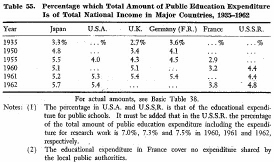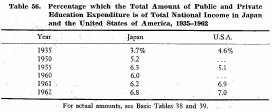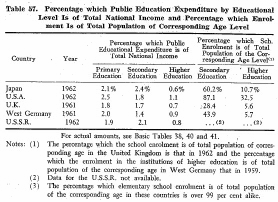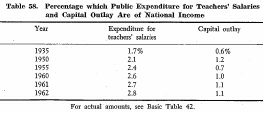| Home > Policy > White Paper, Notice, Announcement > White Paper > EDUCATIONAL STANDARDS IN JAPAN 1965 > CHAPTER |
||
The scale of educational expenditure of a country is primarily decided within the framework of national income. As it is generally accepted that the nations attaching greatest importance to education allocate the largest portions of national income to education, it is made possible to see the intensity of the educational effort of the nations by comparing the percentage which educational expenditure is of national income in each of the nations.
Table 55 shows the percentage which public education expenditure is of total national income in Japan and other leading countries.
The percentage in Japan has tended to rise since the War and, although it declined between 1955 and 1960, it has again increased after 1960.
The five foreign countries listed in Table 55 are the most advanced countries of the world in any of which the national income per capita is larger than that in Japan. The percentage which the total public education expenditure is of the national income in each of these countries has increased continuously during the period reported, the greatest increases occurring since 1960.
In view of the fact that all of the leading countries have in this way been attaching increasing importance to education, which resulted in the steady rise in the percentage which their educational expenditure is of national income, continued effort will be required for education in Japan.

the private education expenditure must be taken into consideration, together with the public education expenditure. With the data available, a comparison was made of the percentage which the total expenditure for both public and private education is of total national income in Japan and the United States of America.
The percentage in both countries has shown a rising trend, but the percentage in the United States of America exceeded that in Japan in 1961 and 1962.

In the following a comparative study will be made on how much weight the leading countries have been placing upon the respective fields of primary, secondary and higher education in appropriating educational expenditure by means of the percentage of the educational expenditure for each of these fields in these countries.

In Japan, the percentage which public primary education expenditure is of national income is next to that in the United States of America, and that of public secondary education expenditure the highest, i.e., 2.4 per cent, but that of higher education expenditure the lowest compared with each of the other countries. The percentages which secondary school and higher education enrolments are of total population of the corresponding ages in Japan are lower than those in the United States of America, but higher than those in the United Kingdom and West Germany. From the above, it must be stated that expenditure for public higher education requires a major increase.
It is certain that the leading countries other than Japan, further increasing the expenditure for education in general, will in future put emphasis upon secondary and higher education in allocating the expenditure. With this in view, it will be necessary also for Japan to make greater efforts to raise secondary and higher education expenditure, especially the latter.
In the following are considered expenditure for teachers' salaries and capital outlay, which are of basic importance for providing education, in relation to the national income.

In Japan, the percentage which public expenditure for teachers' salaries is of total national income has increased slightly each year reaching 2.8 per cent in 1962. The percentage which educational capital outlay is of total national income varied from year to year, but has hardly varied since1960. The greatest single increase, in 1950, was for replacement and rehabilitation of schools destroyed or damaged in the war and for extension of compulsory education. The comparatively large increase of O.3% in 1961 was to meet deficiencies caused by increases in secondary school population.
| Back to Top | MEXT HOME |